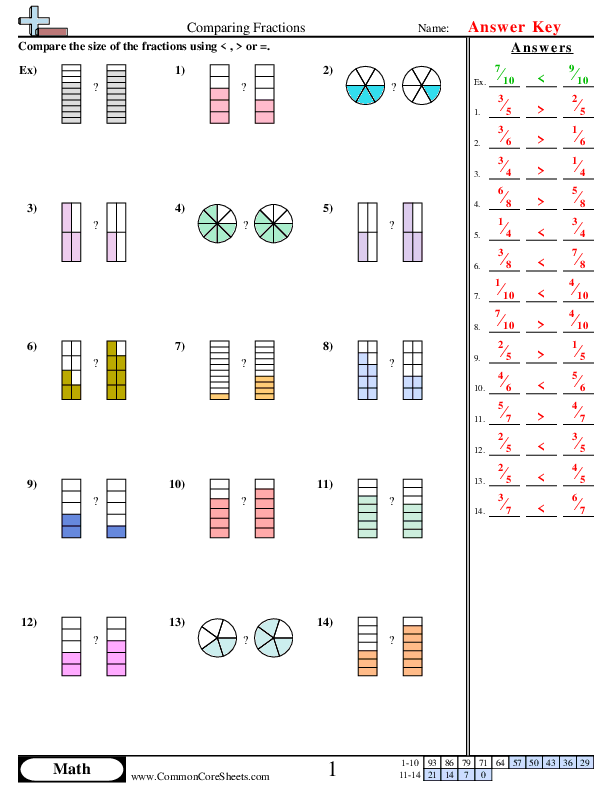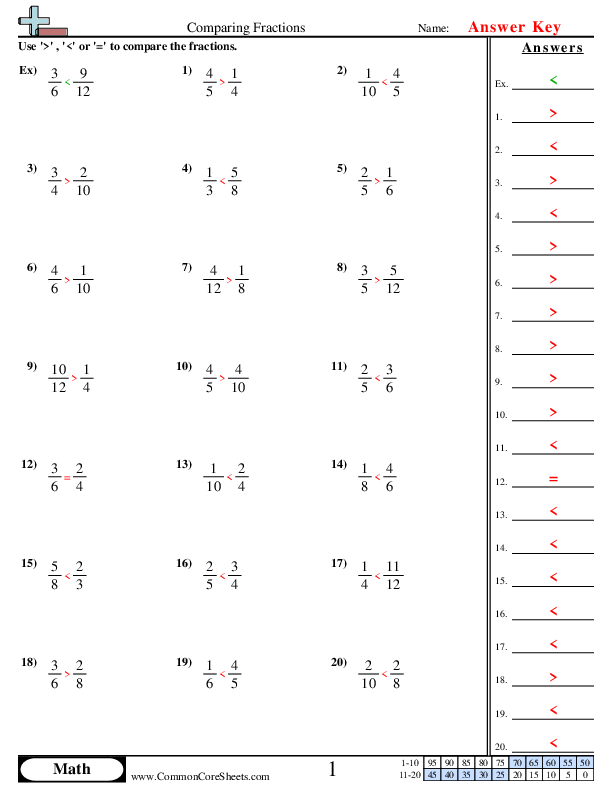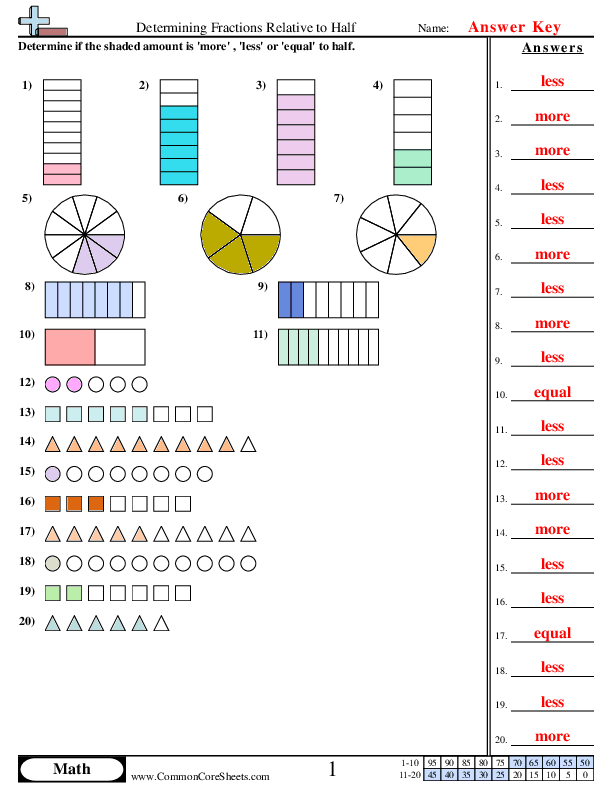Our fraction worksheets are the best on the internet! These free worksheets are perfect for students of all ages who are learning or reviewing fractions. Our fraction worksheets cover a range of skills, from simplifying fractions to adding and subtracting fractions with different denominators. Each worksheet includes clear instructions and plenty of space for students to show their work. With our fraction worksheets, you'll find everything you need to help your students master this important math concept. So why wait? Try our fraction worksheets today and see why they're the best on the internet!
Browse Sheets By Problem Type
×

Comparing Fractions


×
Description:
"This worksheet is designed to enhance children's understanding of comparing fractions through engaging and visually appealing math exercises. It features 14 unique problems, utilizing dynamic graphics to aid comprehension. The customizable content can be transformed into flashcards to facilitate seamless learning, making it an excellent resource for distance learning programs. It offers a fun, interactive way to learn an essential math skill."

×
Student Goals:
Understanding FractionsAfter completing the Comparing Fractions worksheet, students should have a solid conceptual understanding of fractions. They should be able to recognize and identify fractions in various formats and understand what these fractions represent.Comparing FractionsStudents should be able to accurately compare fractions. They should have gained an understanding of how to determine which of two fractions is greater or smaller, and they should be able to order fractions from least to greatest or vice versa. They should also be familiar with the concept of equivalent fractions.Problem Solving SkillsThe worksheet should improve students' math problem-solving skills. Students will be able to approach problems related to fractions methodically, deploying suitable strategies for their resolution. They will know how to break down complex problems into manageable parts.Application of LearningsAfter working through the worksheet, students should be able to transfer their knowledge about fractions into solving real-world problems. They should be able to perceive the relevance of fractions in daily life situations like cooking, shopping, and time and distance calculations.Independence in LearningThe worksheet is envisaged to enhance students' ability to learn independently. It should encourage students to explore the different methods of comparing fractions for themselves, to understand the pitfalls and advantages of each method, and to select the most suitable method for a given problem.Building ConfidenceCompletion of this worksheet should also build confidence in students. As they improve their ability to compare fractions correctly, they will gain confidence in their math skills. This increased confidence and familiarity with fractions can comfort them when dealing with more complex mathematical problems in future.



Comparing Numerically (Different Denominator)
4nf2


×
Description:
"This worksheet is designed to strengthen children's understanding of comparing fractions in math. It contains 20 distinct problems, where children will decide if one fraction is greater than, less than, or equal to another. Dynamic and engaging, this material can be customized based on learner's needs. It also has the capacity to be converted into flashcards for a more visual approach and is adaptable for distance learning, maximizing instruction during remote education sessions."

×
Student Goals:
Understanding of FractionsUpon completion of the worksheet, students should have an improved understanding of fractions. They should be able to identify the numerator as the number that represents a part of the whole and the denominator as the total number of parts in that whole. Recognizing these aspects of fractions is fundamental to further mathematical learning.Comparing FractionsStudents should have mastered how to compare fractions effectively. They should be able to determine if a fraction is less than, equal to, or greater than another and justify their reasoning. The comparison of fractions is a fundamental skill that students will utilize in various aspects of their lives, from simple daily activities to complex problem solving in future mathematics studies.Proportional ReasoningThis worksheet should provide students with a clear understanding of proportional reasoning concepts. Through comparing fractions, students should begin to grasp the reciprocal relationship between the numbers in a fraction and the principled way in which they interact. This essential comprehension will assist them in solving more sophisticated mathematical problems down the line.Augmented Problem-Solving AbilitiesBy completing this worksheet, students should significantly improve their problem-solving abilities. They will enhance not only their critical thinking skills but also their ability to apply mathematical principles to solve problems systematically. This improvement will definitely provide a solid foundation for more complex mathematical tasks that they will encounter through their educational journey.Familiarity with Fractional NotationHaving worked with a variety of fractions on this worksheet, students should develop a familiarity with fractional notation. They should understand the differences between proper and improper fractions and be able to recognize equivalent fractions. This understanding of fractional notation will greatly assist them when they progress to additional math subjects such as algebra and calculus.Build ConfidenceCompletion of the worksheet should instill a sense of mathematical confidence in the students. Familiarity and understanding of the topic should reduce math anxiety and encourage students to take on more challenging mathematical concepts. Handling complex problems with ease will boost their confidence and enhance their overall academic performance.



Less, More or Equal to half (Evenly divisible)
4nf2


×
Description:
"This worksheet is designed to educate children on the concept of fractions relative to half in a math context. It encompasses 20 distinctive problems, ranging from basics such as 3/6 to more challenging instances like 5/8. Perfect for distance learning, the worksheet is flexible, allowing for user customization and a seamless conversion into flashcards to enhance comprehension and memory retention. Ideal for instilling a strong foundation in fractions."

×
Student Goals:
Understanding of FractionsAfter completing the worksheet, students should have a deeper understanding of fractions. They should be able to identify numerators and denominators and what they represent in the context of a whole. They should understand how fractions are used to represent portions of a whole, and how different fractions can express the same value.Conversion SkillsStudents should be able to convert fractions to their simplest form. For example, they should know that 2/4 is the same as 1/2. They should also be able to convert improper fractions to mixed numbers, and vice versa. Their ability to compare and order fractions should also be enhanced.Relating Fractions to HalfAn important learning outcome is for students to understand fractions relative to the value of one half. They should appreciate how different fractions are smaller or larger than one half. They should be able to make estimations about the value of fractions based on their relation to one half.Problem Solving SkillsCompletion of the worksheet should also bolster students' problem-solving skills. Not only will students answer specific problems, but they will also apply concepts and strategies learned to solve new, unfamiliar fractional problems. This applies their understanding in a practical and meaningful way.Math Language and TermsThe worksheet should arm students with the correct mathematical language and terms. They should be able to use the proper terminology and symbols when representing and discussing fractions. This helps them to effectively communicate their mathematical thoughts and understandings.Confidence in MathematicsLastly, successfully working out fraction problems can boost students' confidence in their math abilities. They should feel encouraged to further explore and learn more complex fraction concepts and other areas of mathematics. Overall, the enhanced confidence could foster a positive attitude towards learning mathematics.



Comparing Fractions with Addition & Subtraction
4nf3d


×
Description:
"This worksheet is designed to strengthen children's grasp on comparing fractions. Through a series of 15 math problems, kids will exercise their skills in recognizing larger, smaller, or equal fractions. In a fun, interactive format, they'll also practice addition and subtraction using fractions. The worksheet is fully customizable, making it a versatile tool for in-person or distance learning. There's also an option to convert the problems into flashcards, enhancing the learning process."

×
Student Goals:
Understanding of FractionsAfter completing the worksheet, students should have developed a stronger understanding of fractions. They should have a grasp of the concept that a fraction represents a part of a whole and be able to identify the numerator and the denominator. They should understand what these parts signify, with the numerator indicating the number of selected parts and the denominator reflecting the total number of equal parts in a whole. The worksheet should make students comfortable in navigating the fundamental notion of fractions.Ability to Compare FractionsThe worksheet aims to strengthen the student's ability to evaluate and compare fractions. By solving the problems, students should understand how to discern whether a fraction is larger or smaller than another, recognizing the role of the numerator and the denominator in this process. Comparative signs in the problems should enforce this understanding. It is expected that students will develop their comparative skills with fractions via this worksheet.Fraction Addition and SubtractionA key accomplishment of completing the worksheet is the ability to add and subtract fractions. It should assist students in understanding the procedures of the addition and subtraction operations on fractions. They should be able to accurately add or subtract fractions with the same denominator, a keystone in fraction arithmetic.Problem-Solving SkillsThe worksheet is designed to equip the students with the crucial skill of problem-solving. By working through the problems, students should not only employ their knowledge of fractions but also their logical and analytical abilities. They should be proficient in understanding the problem’s requirements, devising a plan to solve the problem, successfully executing the plan and finally, reviewing the process.Enhancement of Numeracy SkillsAfter completing the worksheet, there should be an overall enhancement of the student's numeracy skills. The exercise of deduction, comparison and calculation involved in these maths problems should bolster the student's proficiency in dealing with numbers and mathematical problem-solving. The worksheet is designed to promote critical thinking and improve numeracy skills.



Determining Value Relative to Half
4nf2


×
Description:
"This worksheet is designed to educate children on the concept of fractions and their relation to half. Through 20 math problems, kids will enhance their numeracy skills and develop a better understanding of fractions. The worksheet can be customized according to individual learning needs, converted into flashcards for interactive study or used for distance learning, thereby offering a flexible, educational tool for children's mathematical development."

×
Student Goals:
Understanding Basics of FractionsAfter completing this worksheet, students should have a firm understanding of the basic principles of fractions, particularly in relation to halves. They will understand that a fraction represents a part of a whole and they will improve their ability to visualize this concept, enhancing their essential fraction comprehension. The exercises will improve their speed, efficiency, and accuracy in identifying and working with fractions.Comparing and Classifying FractionsThe worksheet will enable students to develop advanced skills in comparing and classifying fractions. Through their work with the problems, students will learn to differentiate between fractions that are more than, less than, or equal to half. This fundamental but important skill helps children appreciate the relative size of fractions, which is invaluable in advanced mathematical comprehension.Fraction Arithmetic SkillsAfter completing the worksheet, students should acquire hands-on practice in performing basic fractional arithmetic. Through the problems presented in the worksheet, students will fine-tune their ability to perform different mathematical operations with fractions, including addition, subtraction, multiplication, and division.Application of Fraction KnowledgeThe worksheet will also help students understand the applicability of fractions in real-life scenarios. After engaging with this worksheet, students will gain insight into how fractional knowledge can be transferred to everyday activities like cooking, shopping or sharing. Thus, making fractions less theoretical and more practical for students.Problem-Solving and Critical Thinking SkillsBy working on the problems in the worksheet, students will improve their problem-solving and critical thinking skills. Each problem will push them to think critically, strategize, and apply their fractional knowledge to find the best solution. These skills extend beyond mathematics, contributing to the overall intellectual development of the students.Foundation for Advanced MathematicsLast but not least, by mastering fractions in relation to halves, students will build a solid foundation for more advanced mathematical concepts. Fractions serve as a stepping stone to decimals, percentages, ratios, and algebra. With a firm grasp of fractional understanding, students will be well-equipped to tackle these advanced topics when they encounter them in higher grades.






